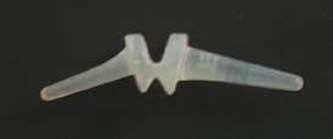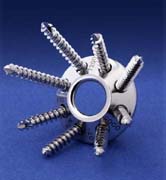Arnold-Peter Weiss, MD
Professor, Orthopedic Surgery Brown University

Reported by David Nelson, MD May 20, 2000 Reviewed by Arnold-Peter Weiss, MD
Peter started his talk by disclosing his financial relationship with DePuy, the maker of the Neuflex Silastic MCP implant (inventor, royalties) and with KMI, maker of the Cobra Wrist Fusion Plate and the Spider Carpal Fusion Plate (inventor, investor).
Neuflex Silastic MCP Implant
Several years were spent examining the kinematics of the MCP joint and the Swanson Silastic MCP implant, manufactured by Wright Medical Technology. The new design has a larger moment arm for both the flexor and extensor tendons and therefore they had a larger torque on the joint. (Peter defined the torque as the cross product of force vector and the moment arm, which I think only the engineers in the audience understood, and they already knew what a moment arm was!) The Swanson is basically a flat prosthesis, with little increase in height (see below) to function as a tendon moment arm. The DePuy Neuflex has blocks at the end of each stem that act a a tendon moment arm.

Swanson Silastic MCP Implant

DePuy Neuflex Silastic MCP Implant
The Swanson implant is at full extension when at rest; the Neuflex is at 30 degrees of flextion. This design is to help decrease the stresses in the silastic material. The devices were taken through flexion failure testing to 10 million cycles without failure. We also examined the center of motion for the MCP joint and compared it to the Swanson and the Neuflex. (The results of this study have been reported at the ORS - DLN.) We found that there was less pistoning of the Neuflex implant in the medulary canal, which we think may yeild less wear debris.
Dr. Weiss has performed a clinical study of the Neuflex, in conjunction with my fellowship mentor, Dr. James Strickland. They have followed 50 patients (46 RA, 4 OA) for 14 months. The ranges of motion are as follows:
Finger |
flexion |
extension |
Index |
75 |
15 |
Middle |
78 |
14 |
Ring |
73 |
13 |
Small |
65 |
7 |
No fractures of the implants have been found and the patients are satisfied. Although we have followed these patients now for longer than 14 months, we have not analyzed the data. However, they seem to be doing well with a similar range of motion.
KMI Fusion Plates
Dr. Weiss has also designed two plates for fusions in the wrist. The complete wrist fusion plate is called the Cobra plate and the four-corner fusion plate is called the Spider plate.

Cobra Plate

Spider Plate
He has used both of these plates clinically. The Cobra plate needs to be set into the capitate (take an osteotome and remove some of the capitate) in order to allow the wrist to be in slight extension. (My experience with the plate is limited to one case, and I agree with Peter that care must be paid to how the plate is applied, or the wrist can be in neutral or even slight flexion - DLN.) He tends to conform the bone to the plate rather than the plate to the bone. The Spider plate has a reamer that allows it to be recessed into the carpus.
Reported by David Nelson, MD May 20, 2000
Reviewed by Arnold-Peter Weiss, MD
This talk was sponsored by unrestricted educational grants from Norcal Mutual Insurance Company, a medical malpractice insurance company; Searle, makers of Celebrex; and KMI, manufacturers of the Cobra and Spider plates.
